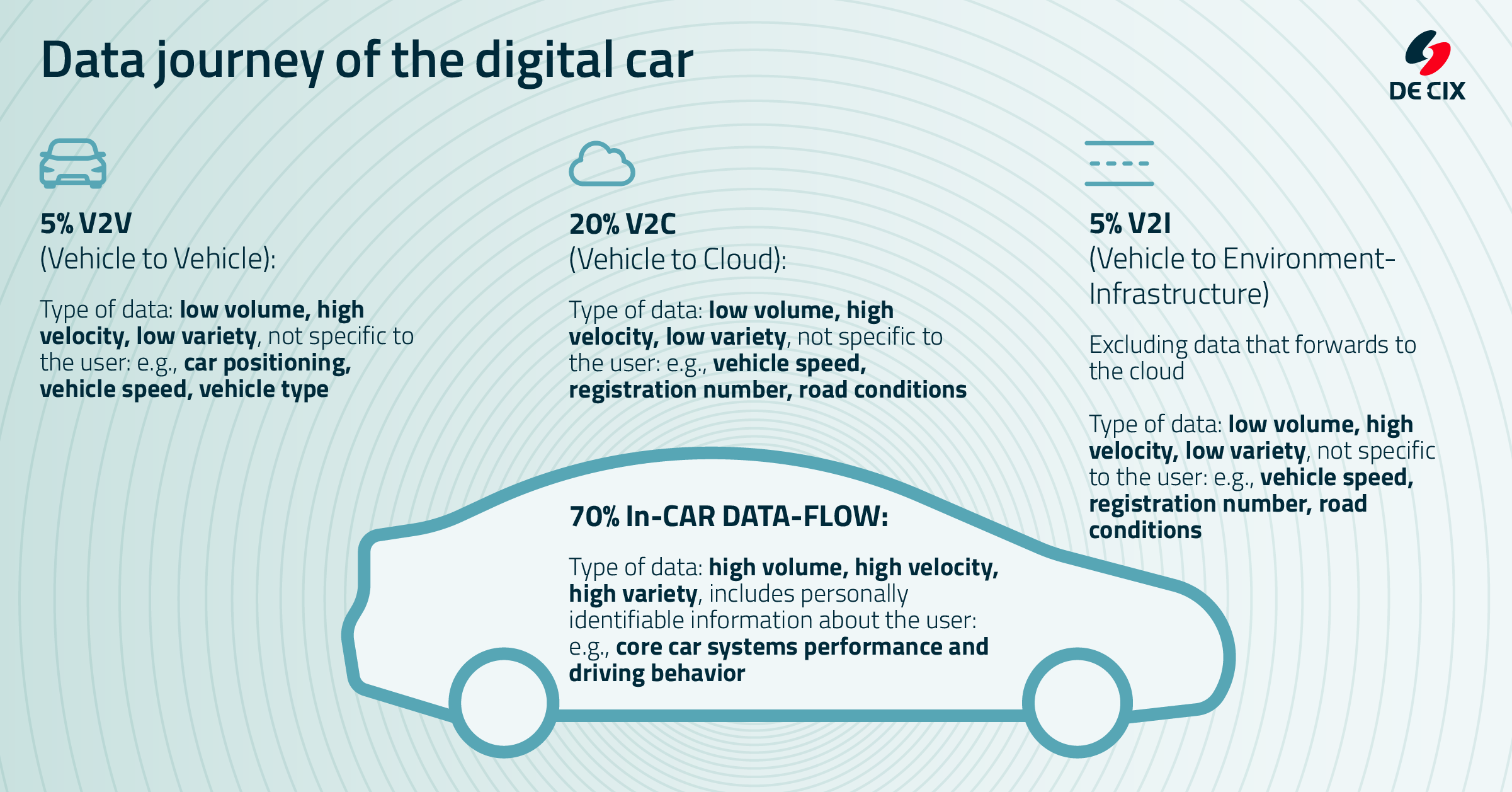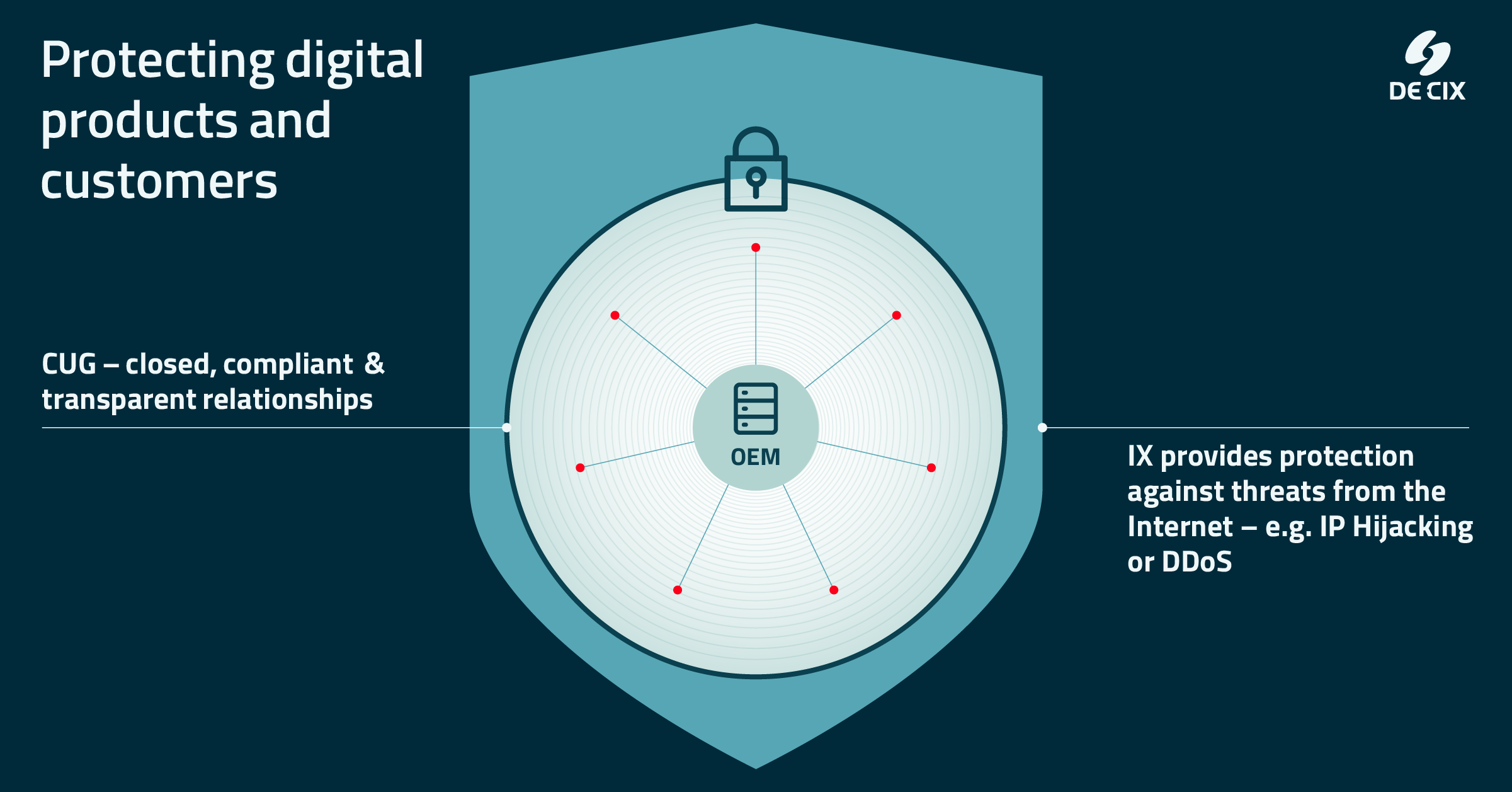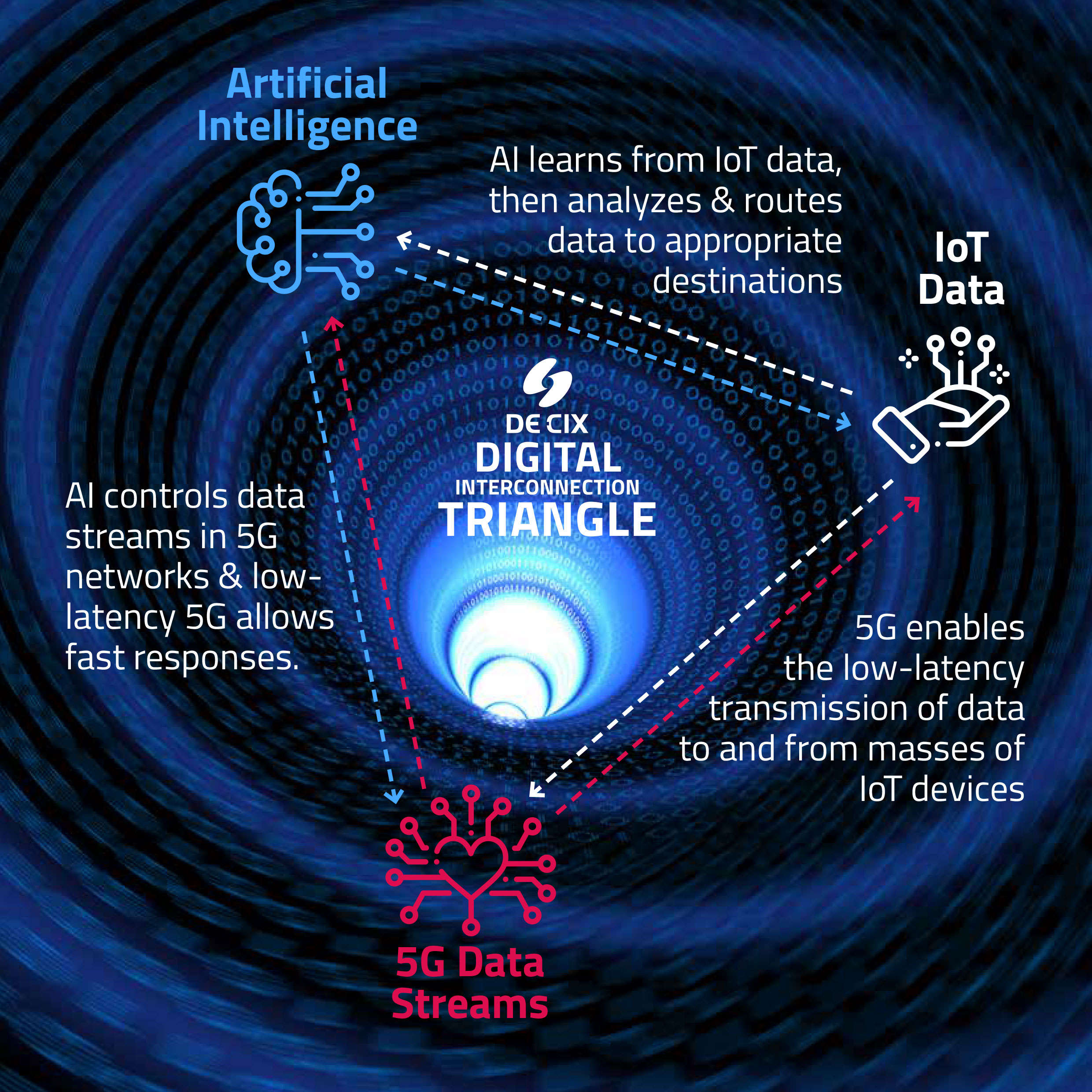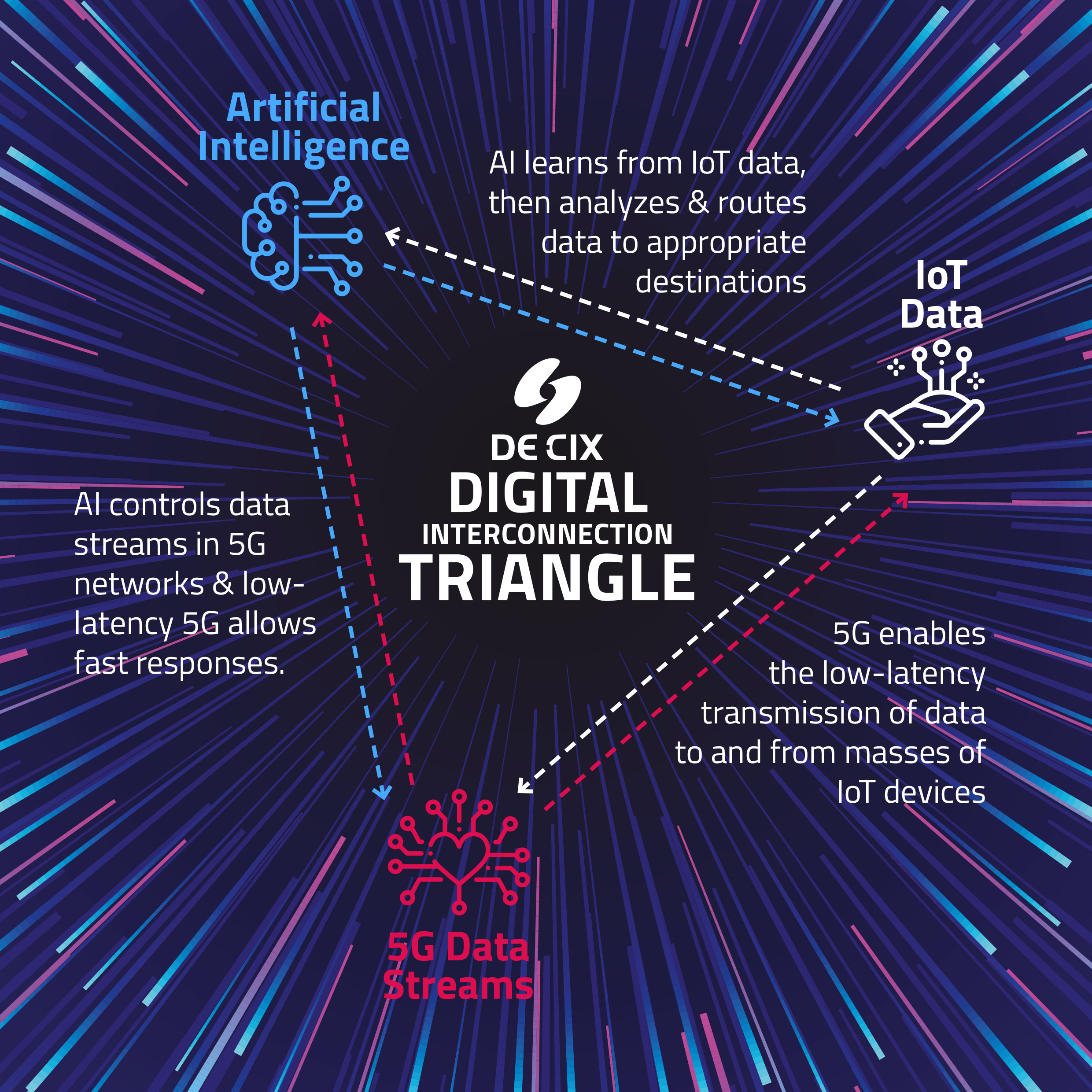In five years, cars will not only provide extreme comfort and entertainment but will also turn into an office and even a classroom, according to DE-CIX International CEO Ivo Ivanov. He calls this development the “fifth screen” entering our lives.
Consider yourself a fleet driver of a big company. You need to complete a delivery on time and get stuck in the traffic jam. In today’s world this may prove to be a difficult situation to resolve. But in a few years’ time, all around the world, cars using the digital infrastructure provided by Internet Exchanges (IXs) will be able to deal with any situation. Your state of the art navigation system will guide you to the shortest route or you will simply deliver all the necessary updates to other fleet cars in your radius so they will be able to help you.
The example above represents only one development out of thousands which smart cars will offer to us in the near future. With an environment fed with thousands of sensors, a “Closed User Group” (CUG) for controlling the data journey, and mini data centers at every other intersection the digital experience cars will offer to us will significantly increase.
DE-CIX International CEO Ivo Ivanov simply defines future smart cars as “a smart digital device on wheels.” With the ongoing developments in technology, including 5G, Ivanov believes that smart cars will turn into the fifth screen in our lives, providing any kind of information and entertainment, thus totally changing our experience on the road.
I had the chance to ask Mr Ivanov about the current and future developments in IX technology and what challenges and opportunities will emerge through it. Ivanov thinks the biggest challenges will be faced in developing the necessary technologies and also plugging every hole against cyber attacks. On the other hand, with super fast real-time connection with minimum latency, the quality of our lives will improve dramatically.
Mr. Ivanov explained how will this happen, by answering the following questions:
What will be the impact of ICT technology in the automotive sector?
IXs will play a role in the automobile industry firstly when it comes to the cloud connectivity of different applications into the car, but even more in serving the in and outbound data of the car in a Closed User Group approach. If, as they all desire nowadays, an automotive company wants to create excellent digital services in the car – aside from autonomous driving, so, for instance excellent entertainment systems – this requires the highest performance possible. Reliable delivery of the applications, high quality audio and video without any outages, is what the companies want to achieve. Therefore, the car has to be very well interconnected with application providers.
This can be Microsoft, for instance. By using an IX, interruptions occurring between the car manufacturer’s network and applications like Microsoft Office 365 and Microsoft Teams can be minimized almost completely. IXs play a crucial role at this point by providing a direct interconnection to the access network and the application networks to which the car is connected. So, a CEO sitting in the backseat of a car which is fully digitalized and connected can enjoy the best quality of video conferencing. Also, the driver can use the best navigation technology available and other passengers can use information and entertainment systems they wish to use. That’s all about performance and latency. So, IXs deliver reliable, highly secure and efficient technology to automotive companies to access these applications delivered into the car.

Can we say that smart cars are turning into offices?
I believe that today’s smart cars have already partly turned into offices, and this will be even more the case in the future. I am looking at this from a different perspective, and define cars as a smart digital device on wheels. It’s a digital engine on wheels and the so-called fifth screen as some have referred to it. The reason why I call it the “fifth screen” is because it replaces the living room and the office and it is also a huge engine producing data. The information gathered by thousands of sensors are not only displayed in the car, but this data creates a multi-billion-dollar industry including outside of the car. You can think about data relevant to traffic management, commercial industries, healthcare, insurance, finance and so on. A very simple example for the limitless list of stakeholders is municipalities, which are extremely interested in the administration of their cities. They want to know the quality of the streets, what causes damage, and how this damage can be fixed and the quality improved. This is something that the cars today can deliver as a real-time information.
What kind of data interaction will occur between cars in the future?
The car will become a very powerful engine and a marketplace for data – data that is very important for the future of the automotive industry and represents a future of growth. Because alongside to the engine, the nice design, and also the physical parameters of the cars, an automotive company today is at the same time a digital mobility company today. The ambition is to create the best possible experience for the driver and the other passengers in the car. And today, the experience of digital services can’t be great if those services don’t work properly. Except the specialized racing cars and the like, we can’t imagine a normal car today not providing the comfort of digitalization that we already enjoy in the rest of our lives. I’m talking about systems which allow us to focus better on the road and traffic conditions to find the best route out of a traffic jam. Also providing the best entertainment and infotainment systems to passengers. There are already prototypes for the next steps in automotive services and systems which are very impressive. For instance, the windows of the car can be used to provide details of the environment the car is in. Even architecture or history lessons can for example be provided while driving through historical and important areas, and so on. All of this will influence the way a car is used and digitalization will become one of the most important factors for consumers when it comes to purchasing a car. This is something the automotive companies know and they want to gather digital assets to be put inside the car. And they can’t do this if they can’t control the data journey.
The data journey is the data entering and exiting the car, and what is done with it. Think about thousands of sensors producing data. As of today, 70% of the data produced by a car is real-time in-car data, involving the core car systems. Added to this, the remaining 30% is made up of 20% car-to-cloud data, which is related to a lot of real-time applications, 5% car-to-car data in live traffic situations, and 5% car-to-environment, which represents the interaction between the sensors and the traffic systems and so on.
When we look at this 30% of the data, we see that it is, firstly, extremely quality sensitive and also extremely security sensitive. As we all can imagine, this data has to be exchanged in a 100% reliable and secure manner, so the real-time performance of different applications and tools can work as desired.
Would it be possible to provide total privacy for consumers?
This is a job of all of us, all the stakeholders included in this business. It starts with a car manufacturer and also entails application providers, but infrastructure providers also have a part to play in this industry. The concept of the Closed User Group (CUG), as I mentioned in the beginning, perfectly fits into this type of requirement. Why? Because it is a controlled virtual environment, where the owner of the CUG – in this case, the automotive company – can make sure that all the policies needed are implemented to ensure compliance. These can be security, privacy and further other requirements stipulated by the company itself or by regulators and other stakeholders. These policies can be controlled and monitored in this environment and every single participant who is invited to this Closed User Group and exchanges data with the cars – for example, streaming services, data analytics companies and cloud services – are obliged to comply with these policies. So, on the one hand, it becomes extremely manageable in terms of compliance. On the other hand, it is highly secure. Because, in this CUG, the interconnection between the network of the car company and the networks which deliver data to or receive data from the car is direct. There’s no intermediary in between. And the more the exchange of direct data is, the better the control over it is. Also, the risk of manipulation by an anonymous party will be dramatically reduced. Of course, there is no such thing as absolute security, but automotive manufacturers need to get as close as possibel. And this concept is extremely secure, as it is massively reduces the risk of DDoS attacks because of the direct exchange of data. It also allows the tracking of the data flow and mitigation of any possible lags in a very reliable manner.

Are smart cars ready to prevent any kind of cyber attack?
This is an extremely important question and also an extremely important area of discussion, because we can all imagine what kind of risks can be related to a situation where a criminal can hijack the car, steal the identity of the driver, and even take control over the car. The car can be literally used as a weapon in the hands of terrorists or criminals. To avoid this, secure infrastructure becomes extremely relevant and the infrastructure I’m talking about, the Closed User Group in the automotive industry, is a very important tool to gain control of security-related systems. Because of the direct interconnection and the private and isolated environment, attacks like IP hijacking or DDoS can be isolated and mediated. In fact, criminal intent on performing such an attack generally want to remain anonymous. In a CUG, there’s no anonymous party. So, this will allow the owner of the CUG, in this case the car company, to perfectly control the data buyers and data suppliers. Having said this, because of the closed environment, it is extremely hard for criminals to hijack the car and steal the driver’s identity or take over the control of the car. And of course, next to this, the manufacturers in the automotive industry are extremely sensitive about security and there are more and more measures to be put in place to make sure that even in the very theoretical case where these systems did not perform, they must make sure that they have a Plan B solution in order to stop the car and avoid any accident and damage.
How does the Blackholing technology work?
Blackholing is a very effective tool to prevent any damage caused by the DDoS attacks. The Blackholing logic has been installed in every DE-CIX platform and location. It identifies anomalies in the traffic volume which are not related to the normal parametrics and in this case digitally trashes it into a “blackhole”, while the pipes and the networks stay open for the normal and real traffic and the congestion can be avoided. The DDoS traffic which aims to disrupt the data flow or significantly damage the system is not effective against Blackholing and disappears in a blackhole.
What are the challenges and opportunities of IX technology?
The main challenge first of all, is the entire process of digitalization – which we take as one of the major paths of innovation now and in the years ahead of us. To make sure that the experience of digital services will be available, interconnection is one of the biggest challenges. As we all know, a car is to be driven. In this case, digital services need to be performed even in the rural areas, outside the cities, where the infrastructure is not yet sufficiently rolled-out to enable these services. This is one of the main challenges for different stakeholders involved in this industry. As DE-CIX, we have already created a platform which will allow us to build exchanges close to highways junctions and 5G cell towers, to make sure that localized interconnection between the application networks and the car access networks can take place as locally as possible in a radius of around 80 to maximum 100 kilometres. This infrastructure is one of the biggest challenges in our eyes, and also in the eyes of the car manufacturers, when it comes to digital services.
When we look at the opportunities, they are unlimited. This can create a wave of innovation and a wave of creation of very helpful services to improve the efficiency of the way we drive safely. I think this is one of the main opportunities the entire value chain of the stakeholders have in our hands. Through the digitalization of infrastructure we can offer the safest and the best experience ever.
How do you see the development process in technology and adaptation of 5G?
Let me start with the last element in your question. The reaction is not as fast as probably the desire for innovation and progress. We have to increase the speed of 5G deployment because enabling this technology almost everywhere will allow us to enjoy the Internet of Things (IoT) in a way it should be enjoyed. Because that’s what 5G is all about. The mediation of different data streams from the IoT devices. When you look at the parts and sensors of the cars they are actually IoT devices. And having this technology everywhere will dramatically increase the efficiency of data management in a very intelligent way. 5G is extremely important for our use of digital technology everywhere and not only in our living rooms. EIXDE-CIX has realized the importance of 5G in its edge interconnection triangle. The DE-CIX edge internonnection triangle consists of 5G technology, artificial intelligence (AI) and the last element is localization of the infrastructure on site. This gives us the ability to use devices and applications regardless of where we are.
What is the development process you want to accomplish until 2025?
As DE-CIX, by 2025 ECIXwe desire to be involved with and partner more telecommunications players worldwide. Also, to get involved in the creation of new hubs. We already achieved this for instance in Southern Europe, creating interconnection hubs in Madrid, Marseille, Lisbon and Palermo. Of course, together with our data center partners, cablehave succeeded in supporting the trends in traffic distribution, which are definitely trends about creating new hubs. One focus is regions which have not been served locally in the past years – continents like Africa, South America, remote areas in India, Southeast Asia and rural areas in the US, for example. Our vision is to provide reliable, flexible, affordable solutions not only to big hubs, as we do today in New York, Madrid and İstanbul, but also in rural areas where the so-called edge interconnection needs to be built out and small relevant hubs will start to appear. There is a good reason for this: The closer the applications are to the users, the better the experience. So data centers are needed at the local level where applications and different services, like cloud computing, are hosted for local users, and we would be involved in interconnecting these applications and resources to the Internet access network as locally as possible. This is our ambition for the next 5 years. So in 2025, we want to be present on all continents with our platforms to make sure that different economies will benefit from better infrastructure. And as I love to say, better infrastructure creates a better digital service experience. And this better experience is our key to a better life today. Because if people don’t have access to these services they’re simply disadvantaged – and we want to close this gap.


What will be the main development in smart cars in the coming five years?
I believe digitalization in every part in the car will be the main driver. In 2025, we will experience extremely smart cars which will be supporting our daily lives with comfort and entertainment.
How will a consumer best benefit from the technologies of DE-CIX?
Using applications in the office or from home – applications such as CRM, ERP or simply email and video conferencing, with team members requiring 100% mobility – with the best performance possible as a result of the lowest latency. As we see in our industry, every millisecond counts: We say latency is the new currency! At DE-CIX we have had great success in improving latency to Microsoft 356, for example, which our solution can reduce from 70 milliseconds to under 10 milliseconds. And this leads to an incredible increase in the performance of those systems for the people in offices, regardless of where they are. And the company can save resources that would otherwise have been used for troubleshooting and maintenance. Another example is from the gaming industry. We all know that gaming companies are sensitive about latency, especially when it comes to online real-time gaming. For gaming companies, on the one hand, and on the other hand for the Internet access networks, connecting to DE-CIX means that we can make sure the gaming application is delivered along the fastest and the most efficient path possible. So the player using a smart device at home or underway, even in the car, can experience great gaming. The traffic exchange between the gaming company no matter whether it’s on the gaming console or in cloud, and the Internet service operator – which brings the data the last mile to the users – enables this experience.
Do you have a message for the tech world?
We are entering a new era in digitalization everywhere and our ambition is to support this with our services, and we have a wish that goes out to all the different stakeholders involved in digital infrastructure. We invite all of our partners around the globe, data centers and network operators to collaborate, in order to bring the best Internet infrastructure to everyone, everywhere.


